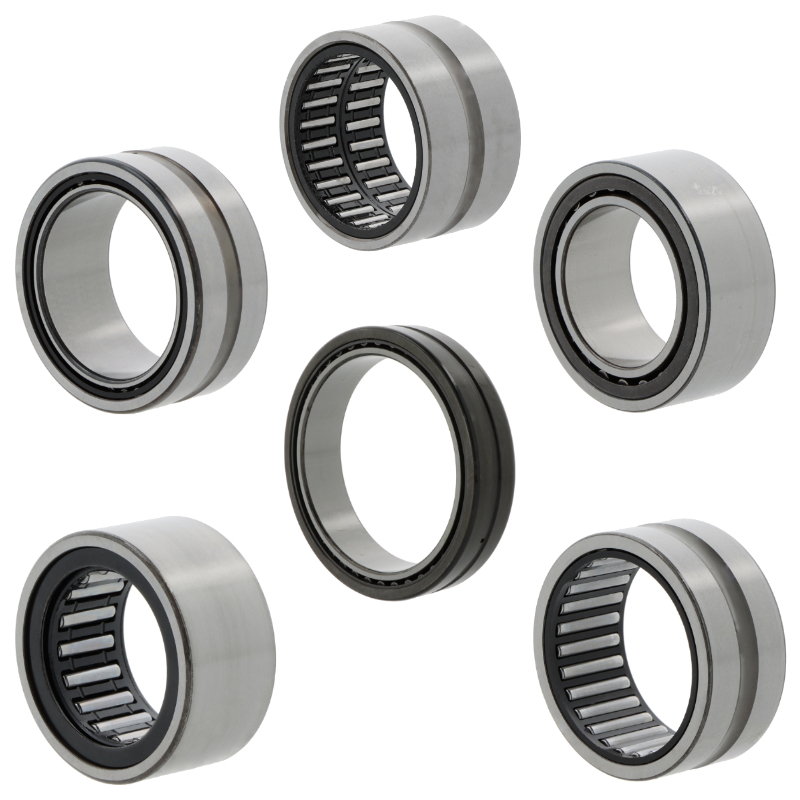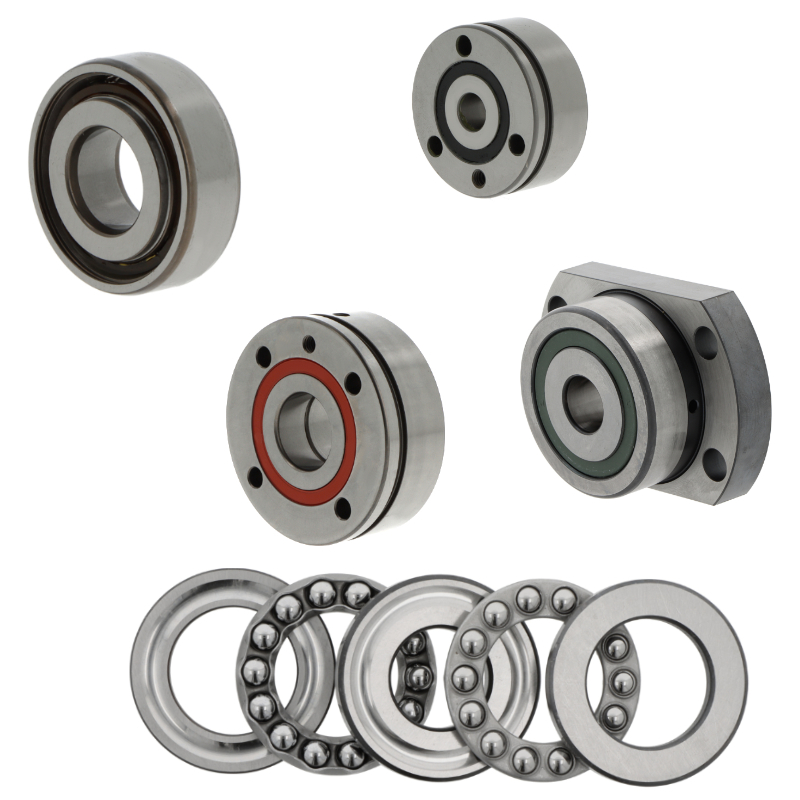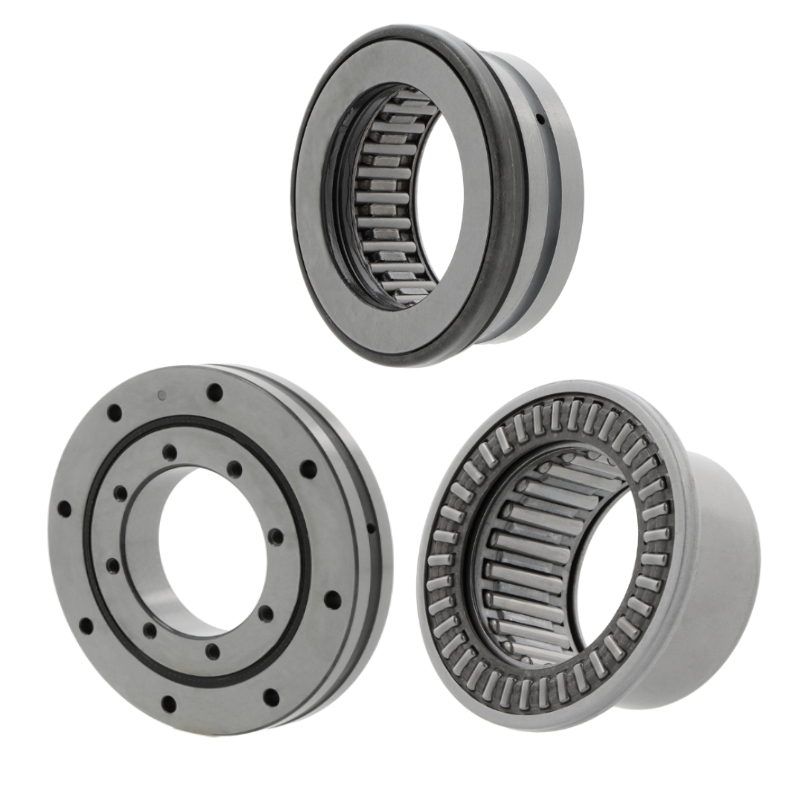Rolling bearings are mechanical components used in a variety of applications to reduce friction between moving parts and enable low-friction rotary or linear motion. They consist of inner and outer rings, rolling elements (such as balls or rollers), and a cage that separates the rolling elements and stabilizes their position.
The main function of a rolling bearing is to support and transfer loads while allowing low-friction movement. By using rolling elements between the inner and outer rings, friction is significantly reduced compared to plain bearings. This leads to more efficient and durable support for rotating or linearly moving components.
Rolling bearings are used in nearly all areas of industry and mechanical engineering. They can be found in automobiles, airplanes, rail vehicles, ships, electric motors, pumps, compressors, household appliances, machine tools, and many other devices and machines.
The advantages of rolling bearings lie in their efficiency, ability to carry high loads, precision, and low friction. They enable low-friction movement, reduce wear, and extend the lifespan of machinery and equipment.
However, rolling bearings require regular lubrication to ensure smooth operation and can be damaged by insufficient lubrication or contamination. Additionally, rolling bearings can be sensitive to shock loads and vibrations and require precise alignment to ensure optimal performance.
Applications
Rolling bearings are found in a wide range of applications, from small household appliances to large industrial machines. Ball bearings are widely used in engines, gearboxes, pumps, compressors, electric motors, and many other devices. Roller bearings are used in rolling mills, conveyor belts, construction machinery, wind turbines, and heavy-duty applications. Tapered roller bearings are used in vehicle gearboxes, trucks, axles, and agricultural machinery. Needle bearings are used in applications with high radial loads, such as crankshafts, connecting rods, and camshafts. Deep groove ball bearings are used in high-speed applications such as electric motors, pumps, fans, and air conditioners. Axial or Thrust bearings are used in applications requiring pure axial loads, such as clutches and screwdrivers.
Types of Rolling Bearings
There are various types of rolling bearings, each with different characteristics depending on their design and application. The most common types are:
Ball Bearings (Radial)

They are categorized into radial and axial or thrust bearings. Radial bearings are mainly designed for radial loads and have corresponding weaknesses in axial loads.
Advantages
Ball bearings offer various advantages that lead to their wide application in a variety of industries:
- Low Friction: Ball bearings have lower friction due to the rolling motion of the balls, wasting less energy and enabling more efficient rotation.
- High Speeds: Due to their low friction, ball bearings can achieve high speeds, making them suitable for applications requiring fast rotation, such as electric motors and turbines.
- High Load Capacity: Although ball bearings have lower load capacity compared to roller bearings, they can still handle significant loads, making them versatile for various components.
- Low Maintenance: Ball bearings are generally low-maintenance and require only regular lubrication to ensure smooth operation, reducing maintenance efforts and operating costs.
Applications
The applications for ball bearings are nearly limitless. They are used in a wide range of devices and machines, including automotive applications (wheel bearings, gearboxes), household appliances (washing machines, refrigerators), power tools, office equipment, machine tools, industrial equipment, and much more.
The various types of ball bearings, including deep groove ball bearings, angular contact ball bearings, self-aligning ball bearings, and spindle bearings, each have unique design features and applications to meet specific needs.
Radial Roller Bearings
Types of Roller Bearings
There are various types of roller bearings, each with different characteristics depending on their design and application:
- Cylindrical Roller Bearings: These bearings consist of cylindrical rollers arranged in two rows, capable of handling both high radial loads and certain axial loads. They are commonly used in applications with medium to high loads, such as gearboxes, machine tools, and rolling mills.
- Spherical Roller Bearings: Also known as Self-Aligning roller bearings, these have barrel-shaped rollers that can move within a common spherical raceway ring, allowing for some misalignment and making them suitable for applications with inaccurate alignment or shaft deflection. They are often used in heavy-duty applications such as mining equipment, heavy machinery, and rolling mills.
- Tapered Roller Bearings: These bearings have tapered rollers that move along the tapered surfaces of the inner and outer rings. They can handle both radial and axial loads and are commonly used in applications with combined axial and radial loads, such as vehicle axles and gearboxes for heavy machinery.
Advantages
The advantages of roller bearings include their ability to handle higher radial loads than ball bearings and their ability to deal with certain misalignments. They also offer good shock load capacity, making them suitable for applications with heavy loads and demanding operating conditions.
Some disadvantages include limited speed capacity compared to ball bearings and larger space requirements. Additionally, they require careful lubrication to ensure optimal performance.

Needle Bearings

Hauptmerkmale
Main Features
- Cylindrical Rollers: Needle bearings use cylindrical rollers as rolling elements, which have a greater length-to-diameter ratio compared to other roller bearings.
- Compact Design: Due to their cylindrical rollers and longer diameter, needle bearings have a low height, making them suitable for applications with limited space.
- High Load Capacity: Despite their compact design, needle bearings have a high radial load capacity, making them suitable for applications with high loads.
Applications
Needle bearings are used in various scenarios, particularly when high radial load capacity and compact design are required. Typical applications include:
- Automotive Industry: Used in gearboxes, camshafts, crankshafts, drive shafts, and other vehicle components.
- Industrial Machinery: Used in compressors, pumps, generators, and textile machines.
- Power Tools: Used in various power tools such as drills, grinders, and saws.
- Aerospace: Used in aircraft and spacecraft for various applications, including engines, control systems, and landing gears.
Advantages
The advantages of needle bearings include their ability to handle high radial loads and their compact design, making them particularly suitable for applications with limited space.
Disadvantages include limited oscillating capability, higher friction due to smaller roller diameters, and the need for precise alignment of the shaft and housing to achieve optimal performance.
Axial Thrust Bearings
Thrust bearings are used in applications such as clutches, screwdrivers, and mixers. They offer high load capacity for pure axial loads but have limited capability for handling radial loads.
Types of Axial Thrust Bearings
Axial thrust bearings can be categorized into different subtypes based on their design and type of axial load transmission. Common types of axial thrust bearings include:
- Axial Deep Groove Ball Bearings (Thrust Ball Bearings): These bearings consist of grooved balls arranged in a raceway ring, capable of handling both axial and limited radial loads. They are used in applications such as gearboxes, fans, and worm gears.
- Axial Angular Contact Groove Bearings: These bearings consist of angular balls arranged in two rows on offset raceways, capable of handling high axial loads and certain radial loads. They are often used in applications with combined axial and radial loads, such as worm gears and ball screws.
- Axial Thrust Cylindrical Roller Bearings: These bearings consist of cylindrical rollers arranged in a raceway washer, capable of handling high axial loads and providing limited radial load capacity. They are used in applications such as rolling mills, machine tools, and printing presses.
- Axial Thrust Needle Bearings: These bearings use needle-shaped rollers to handle and transfer axial loads. They are compact and suitable for applications with limited space. Thrust needle bearings are commonly used in automatic transmissions, camshafts, and clutches.
- Axial Thrust Spherical Roller Bearings: These bearings consist of an inner ring, an outer ring, and a series of spherical rollers arranged between the rings. The barrel-shaped rollers slide on concave raceways in the inner and outer rings, allowing the bearing to self-align. This design enables axial thrust spherical roller bearings to handle axial loads while compensating for misalignment or shaft deflection.
- Axial Thrust Tapered Roller Bearings: These bearings consist of an inner ring, an outer ring, tapered rollers, and a cage that separates the rollers and ensures even distribution. The tapered rollers allow optimal handling of axial loads and can handle both single-sided and double-sided axial loads due to their design.
Applications
The applications of thrust bearings depend on the specific design and properties of the bearing type. Generally, thrust bearings are used in machines and equipment where axial loads occur and need to be transferred. Examples of applications include gearboxes, pumps, compressors, axles, and many others.
The advantages of axial thrust bearings include their ability to handle and transfer high axial loads, providing a reliable solution for applications where axial forces act along the axis or shaft. Disadvantages include limited radial load capacity and greater complexity compared to other bearing types. Careful alignment and lubrication are crucial to ensure optimal axial thrust bearing performance and prevent damage.

Combined Axial/Radial Bearings

Structure and Design
Combined axial/radial bearings consist of an inner ring, an outer ring, balls or rollers, and a cage that separates the balls or rollers and stabilizes their position. The inner ring is connected to the outer ring through the balls or rollers. The balls or rollers are arranged at a specific angle to accommodate and transmit both axial and radial forces.
Applications of Combined Axial/Radial Bearings
- Machine Tools: Combined axial/radial bearings are used in machine tools to handle axial and radial loads during milling, turning, and drilling. They enable precise and reliable positioning of machine tool components.
- Robotics: In robotic applications, combined axial/radial bearings support the movements of robotic arms. They can accommodate both axial and radial forces to keep the robotic arms stable while allowing precise movement.
- Automitive Industry: In the automotive industry, combined axial/radial bearings are found in transmissions, differentials, and wheel hubs. They can handle the axial forces occurring during acceleration and braking, as well as the radial load when turning the wheels./li>
- Aerospace: In aerospace engineering, combined axial/radial bearings are used in applications such as aircraft landing gear, control systems, and satellite mechanisms. They ensure reliable movement and stability under the extreme conditions of the aerospace environment.
Advantages
- High Load Capacity: Combined axial/radial bearings can accommodate both axial and radial forces and are capable of carrying high loads.
- Space-Saving: Since they can handle both axial and radial loads, combined axial/radial bearings can reduce space requirements by eliminating the need for separate bearings for axial and radial loads.
- Precision: They offer high precision and rigidity, which is crucial in applications requiring accurate positioning and movement.
Disadvantages:
- Complexity: Combined axial/radial bearings are structurally more complex compared to simple axial or radial bearings. This can impact assembly and maintenance.
- Higher Costs: Due to their special design and ability to accommodate both axial and radial loads, combined axial/radial bearings are generally more expensive than individual bearings for axial or radial loads.
Products
Selection of Rolling Bearings
When selecting rolling bearings, several factors need to be considered to find the right bearing type and specification for the specific application.
Important selection criteria include:
- Load Capacity: Determine the load capacity required by the application, including both radial and axial loads. Choose a bearing type that meets the required load capacity while considering the load direction.
- Speed Capacity: Consider the speed capacity of the bearing. Ball bearings typically have a higher speed capacity compared to roller bearings. Ensure that the selected bearing can handle the required speeds without excessive heat generation.
- Alignment and Misalignment: Assess whether misalignment or shaft deflection might occur in the application. Choose a bearing type that can accommodate the expected misalignment while maintaining reliable performance.
- Lubrication: Determine the lubrication requirements of the bearing. Proper lubrication is essential for optimal performance and extended bearing lifespan. Choose a bearing that suits the lubrication type and maintenance intervals required by the application.
- Temperature Range: Consider the operating temperature range of the bearing. Ensure that the selected bearing can handle the temperature conditions without significant performance loss or damage.
- Installation Space: Take into account the available space for the bearing installation. Ensure that the selected bearing fits within the space constraints of the application.
- Cost and Availability: Evaluate the cost and availability of the bearing. Choose a bearing that fits within the budget and is readily available for replacement or maintenance.
- Maintenance and Durability: Consider the maintenance requirements and durability of the bearing. Select a bearing that meets the maintenance intervals and lifespan expectations for the application.
Designation system - rolling bearings (ball bearings, roller bearings)
Different manufacturers use various designation schemas to describe the specifications and characteristics of their rolling bearings. These designations include crucial information such as dimensions, load ratings, tolerances, and special features of the bearings. In addition to basic designations, there are prefixes and suffixes that provide additional information about modifications and specific attributes of the bearings. For example, well-known manufacturers like SKF, FAG, and NSK each have their own codes and designation systems, enabling the quick identification of the suitable bearing for a specific application. Understanding these designation schemas, including the prefixes and suffixes, is important for making the right choice in bearing selection.
To provide you with better guidance, we have created an overview that explains the suffix codes used in the designations of bearings by leading manufacturers and their meanings. You can find this overview here: Rolling bearings designation system.
